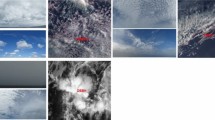Abstract
All fresh-water, whether on the surface or underground, comes from the atmosphere in the form of precipitation. Nevertheless, a large volume of water present in the clouds is never transformed into precipitation on the ground. This has prompted researchers to explore the possibility of augmenting water supplies by the use of “cloud seeding” technique to initiate and accelerate the precipitation process. The seeding technique is expected to provide an increase in precipitation from the cloud and provide rain almost immediately at the targeted region/ location. This is done by dispersing suitable substances into the cloud that serve as cloud condensation or ice nuclei. Although many projects around the world have successfully demonstrated a considerable increase in precipitation due to seeding, majority of the projects, however, yielded inconclusive results on precipitation enhancement [1]. The reason for this inconsistency is that the physical mechanisms of aerosol effects on cloud and precipitation development are much more complex than anticipated earlier. There are many ongoing operational cloud seeding programs and the number has been steadily increasing with time. Despite this, there is still a great need for more intensive FIELD experiments to standardize the cloud seeding technology for increased reliability and enhancement of precipitation from clouds. The technology of rain enhancement is based on the science of cloud physics with major linkages reaching into mesoscale and boundary layer meteorology, weather forecasting, diffusion and turbulence, physical chemistry, aerosol physics, statistics, and instrumentation [2,3,4]. In this paper, we present the details of the multi-wavelength dual polarization lidar being used and the methodology to monitor the various cloud parameters involved in the precipitation process.
Access this chapter
Tax calculation will be finalised at checkout
Purchases are for personal use only
Similar content being viewed by others
References
Zoljoodi M, Didevarasl Ali (2013) Evaluation of cloud seeding project in Yazd Province of Iran using historical regression method. Nat Sci 5(6):1006–1011. doi:http://dx.doi.org/10.4236/ns.2013.59124
Krishnakumar et al (2014) Lidar investigations on the optical and dynamical properties of the cirrus clouds in the UTLS region at a tropical station Gadanki, India (13.5ON, 79.2OE)”. J Appl Remote Sens 8(1):083659. doi: https://doi.org/10.1117/1.jrs.8.083659
Krishnakumar V, Satyanarayana MV, Radhakrishnan SR, Mahadevan Pillai VP, Raghunath K, Venkat Ratnam M et al (2011) Investigations on the physical and optical properties and their role in the nucleation of cirrus clouds using lidar at Gadanki (13.50 N, 79.20E). J Appl Remote Sens 5:053567. doi: https://doi.org/10.1117/1.3662877
Meenu S, Rajeev K, Parameshwaran K (2011) Regional and vertical distribution of semitransparent cirrus clouds and cloud top altitudes over tropical Indian region derived from CALIPSO data. J Atmos Solar Terr Phys 73(13):1967–1979. doi: https://doi.org/10.1016/j.jastp.2011.06.007
Radhakrishnan SR, Satyanarayana M, Presennakumar B, Mahadevan Pillai VP, Murthy VS (2008) Measurement of water vapor in the lower atmosphere at a coastal station, Trivandrum (80 N, 770E) using a high resolution Raman lidar. Indian J Radio Space Phys 37:353–359
Drofa AS, Ivanov VN, Rosenfeld D, Shilin AG (2010) Studying an effect of salt powder seeding used for precipitation enhancement from convective clouds. Atmos Chem Phys 10(1): 8011–8023. doi: https://doi.org/10.5194/acp-10-8011-2010
Parameswaran K et al (2003) Lidar observations of cirrus cloud near the tropical tropopause: temporal variations and association with tropospheric turbulence. Atmos Res 69(1–2): 29–49. doi: http://dx.doi.org/10.1016/j.atmosres.2003.08.002
Sunilkumar SV et al (2003) Lidar observations of cirrus clouds near the tropical tropopause. Atmos Res 66(3):203–207. http://dx.doi.org/10.1016/S0169-8095(02)00159-X
Sassen K (2000) Lidar backscatter depolarization technique for cloud and aerosol research. In: Mishchenko ML, Hovenier JW, Travis LD (eds.) Light scattering by nonspherical particles: theory, measurements, and geophysical applications. Academic Press, San Diego, CA, p 393
Göke S, Ochs III HT, Raube RM (2007) Radar analysis of precipitation initiation in maritime versus continental clouds near the Florida coast: Inferences concerning the role of CCN and giant nuclei J Atmos Sci 64:3695-3707
Author information
Authors and Affiliations
Corresponding author
Editor information
Editors and Affiliations
Rights and permissions
Copyright information
© 2021 Springer Nature Singapore Pte Ltd.
About this paper
Cite this paper
Sudhakar, P., Sheela, K.A., Satyanarayana, M. (2021). Optimisation of Cloud Seeding Criteria Using a Suite of Ground-Based Instruments. In: Laxminidhi, T., Singhai, J., Patri, S.R., Mani, V.V. (eds) Advances in Communications, Signal Processing, and VLSI. Lecture Notes in Electrical Engineering, vol 722. Springer, Singapore. https://doi.org/10.1007/978-981-33-4058-9_33
Download citation
DOI: https://doi.org/10.1007/978-981-33-4058-9_33
Published:
Publisher Name: Springer, Singapore
Print ISBN: 978-981-33-4057-2
Online ISBN: 978-981-33-4058-9
eBook Packages: EngineeringEngineering (R0)



